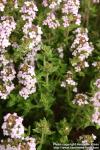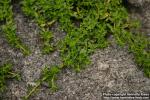Thymus.—Thyme.

 Related entries: Thymol (U. S. P.)—Thymol
- Oleum Thymi (U. S. P.)—Oil of Thyme
Related entries: Thymol (U. S. P.)—Thymol
- Oleum Thymi (U. S. P.)—Oil of Thyme
The herb of Thymus vulgaris, Linné.
Nat. Ord.—Labiateae.
COMMON NAME: Thyme.
ILLUSTRATION: Bentley and Trimen, Med. Plants, 205.
Botanical Source.—Thymus vulgaris, Linné. Thyme is a small under shrub, with erect, suffruticose, numerous, branched stems, procumbent at base, and 6 to 10 inches in height. The leaves are oblong-ovate and lanceolate, numerous, and revolute at the sides. The flowers are bluish-purple, small, and borne in terminal, leafy, whorled spikes (W.).
 Thymus Serpyllus, Linné, Wild thyme, or Mother of thyme, with a decumbent stem flat, entire, elliptical punctate, obtuse, and petiolate leaves, ciliate at base, and purple, spotted, capitate flowers, has similar virtues to the above (W.). A variety of this species is the Thymus citriodora, Schreber (Lemon thyme), having a pleasant, lemon-melissa odor.
Thymus Serpyllus, Linné, Wild thyme, or Mother of thyme, with a decumbent stem flat, entire, elliptical punctate, obtuse, and petiolate leaves, ciliate at base, and purple, spotted, capitate flowers, has similar virtues to the above (W.). A variety of this species is the Thymus citriodora, Schreber (Lemon thyme), having a pleasant, lemon-melissa odor.
History, Description, and Chemical Composition.—These two plants are natives of Europe, introduced into this country, and extensively cultivated in gardens as culinary plants, especially the T. vulgaris. They blossom during the summer. The whole herb is used. It should be collected when in flower, and carefully dried. It has a strong, pungent, spicy, rather pleasant taste and odor, both of which are retained by careful drying. These properties are due to a reddish-brown volatile oil (red oil of thyme), procured by distilling the plant with water. Its specific gravity is similar to that of the oil of origanum, for which it is frequently substituted. The rectified oil is known as white oil of thyme (see Oleum Thymi and Thymol). The herb yields its virtues to alcohol, or to boiling water by infusion.
Action, Medical Uses, and Dosage.—Thyme is tonic, carminative, emmenagogue, and antispasmodic. The cold infusion is useful in dyspepsia, with weak and irritable stomach, and as a stimulating tonic in convalescence from exhausting diseases. The warm infusion is beneficial in hysteria, dysmenorrhoea, flatulence, colic, headache, and to promote perspiration. Occasionally the leaves have been used externally, in fomentation. The oil is valuable as a local application to neuralgic and rheumatic pains; and, internally, to fulfil any of the indications for which the plant is used. Dose of the infusion, from 1 to 3 fluid ounces; of the oil, from 2 to 10 drops on sugar, or in emulsion. Thyme, scullcap, and rue, of each, 2 ounces; peony and black cohosh, of each, 1 ounce; macerated for 14 days in diluted alcohol, and then filtered, forms a good preparation for nervous an spasmodic diseases of children. It may be given in teaspoonful doses to a child 3 years old, repeating it 3 or 4 times a day, sweetening and diluting it, if desired. A strong infusion of the Thymus Serpyllus, slightly sweetened, and mixed with gum Arabic, is stated by M. Joset to be a valuable remedy for whooping-cough, convulsive and catarrhal coughs, and stridulous sore throat, the favorable result occurring at the end of a very few days. It may be taken ad libitum.

